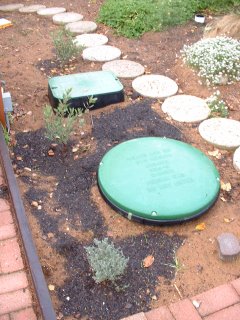ON SITE NITROGEN SEQUESTERING INSTALLED AND FINALED
What have you done on your property to reduce nitrogen from going into the groundwater?
My name is Steven Paige, I own a home on a 25 by 125 foot lot in the prohibition zone. I submitted plans for to reduce nitrogen emissions by 60 to 80 percent from my septic outfall with the County on May 11, 2006 after receiving approval from Harvey Packard. The project was completed and received final inspection by the County on October 23, 2006 and is now in operation.
How does your system work?
My system is very simple. I have two toilets side by side. One is a bidet used for urine only. The other is a toilet used for solids. The urine only bidet faucet is spring loaded and washes the dry bidet bowl with about 1/3 cup per washout. All the urine goes into a parallel holding tank that is pumped and removed from the water basin once or twice a year. One truck can haul a years supply from twenty to fifty households.
How do you verify how much nitrogen is removed?
A C-42 licensed hauler fills a test container and the container is sent to a testing lab and tested for total nitrogen. That small amount is multiplied by the volume removed from the holding tank. The sequestered nitrogen content is subtracted from the assumed EPA output from a normal two person household giving you the percent reduction in contamination.
What does it cost to operate the system?
The total output with flushing water is about 200 gallons a year for two people and the estimated cost for hauling is about $150.00 per year. The system cost less than $1500.00 to install. I also save on my water bill by about 1/5 because of my reduced flushing volume from the bidet. The small square tank in the picture holds access to the Liquid waste tank.
What if you sell your house?
I have a deed restriction for waste nitrogen sequestering recorded with the County that would show up on the title report. Attached to it is exhibit one, a "Nitrogen Sequestering Homeowner's Manual" that would also show up in the title report.
How well is the system expected to work?
Using accepted EPA data, Standardized Medical data on nitrogen in urine and empirical mathematics it can be determined that sequestering is equal to or better than the Nitrogen reduction assumed and permitted for the TRI-W sewer project of 7 ml/l remaining in the balance of septic waste.
How did you come up with the idea?
It is a well researched idea originating in
How would you apply your situation to the CDO process?
I would allow Urine sequestering to be used as a carrot to avoid the CDO process. I would use the once or twice a year pumping tickets and Lab results as verification. I myself asked for a waiver when I submitted my plans for review 5 months ago. I will push soon for another option.
Would you expect this to affect the zero discharge enforcement on your property?
Yes I believe it will. If you encourage people like myself that want to meet much higher standards for their on site waste disposal you get immediate positive temporary remediation of the Nitrogen problem. I would encourage this with a proportional discharge order instead of a zero discharge order for small lots compared to one acre parcels that are approved to discharge as per the basin plan.
A Proportional discharge order would mean that a 50 by 100 foot lot would be allowed 16% to 25% of the pollutant discharge for an acre. As a member of LOCAC land use committee I have seen contemporary one acre approvals include houses with many homes approved on one acre. With one acre as the standard, smaller lots should be allowed a proportional discharge.
An additional settlement agreement for proportional discharge and Urine sequestering would encourage water conservation. People not wanting to jeopardize the value of their property would install a system like mine that any plumber could install. To meet the requirements of the settlement they would have to practice careful water conservation and sequester, pump, and haul urine outside the basin. The agreement would have them hook up to the sewer when available but still be allowed to sequester and discharge if problems arose with the time line construction.
The water board would benefit by having the nitrogen removed immediately. They also would optimize air pollution compared to pumping whole tanks. Sequestering would reduce conformance air pollution by 95% thus avoiding "parallel standards" challanges for CEQA exemptions in air quality aginst the RWQCB. Sequestering/conservation would eliminate Prop 218 benefit challenges that on site secondary treatment may raise if allowed. The solution is a front end solution that would go away when the sewer is hooked up to the house.
Intensive water conservation of this order would require:
- Micro flush 1/3 cup urine flushing in the bidet or European dual flush toilets.
- Second generation HE washing machines.
- Zeroscape landscaping.
- Ultra low flow shower heads.
- Ultra efficent dishwashers.
- Removal of garbage disposals for another 15% Nitrogen reductions (85% total).
- Careful use of water.
With a proportional discharge order from the RWQCB you not only encourage a more usable and efficient sewer system within Prop 218 law but you also jump start smart growth temporary solutions that are married to the future solution of basin groundwater overdraft. Behavior modification is the most efficent method of compliance in the short term.


